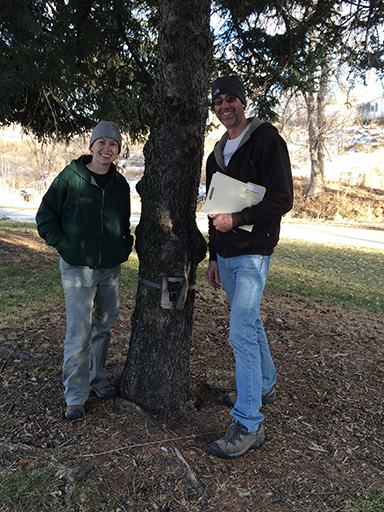 CU in the City research highlights wildlife with focus on education, conservation
CU in the City research highlights wildlife with focus on education, conservation
As city planners grapple with the fallout of explosive growth, eyeing its effect on everything from housing to highways, one University of Colorado Denver graduate student hopes her recently-launched master’s project can make a difference in the future of a vulnerable and often-stealthy metro-area population: the critters that live among us.

Coyote
Results of her first surveillance, thousands of photos shot by strategically-placed motion-detection cameras, turned up everything from Bambi and Wile E. Coyote to Woody Woodpecker and Pepe LePew. "I was surprised by the skunk," said Sarah St. Onge, who is working on her degree in the College of Liberal Arts and Sciences Department of Integrative Biology. "I just haven't seen one in Colorado before, and there it was in the city."
She was not taken aback, however, by the number of foxes, coyotes, raccoons and squirrels her 40 infrared-equipped cameras caught night and day during January, the first of eight seasons her project will include. Even a spike bull elk wasn’t an unexpected guest, as it sauntered past a camera near Golden, on the west end of St. Onge’s select corridor.

Deer
St. Onge hopes her project, a partnership with the Chicago-based Urban Wildlife Information Network, will connect CU and the city by offering planners and park managers a snapshot of the population dynamics of the mammalian species that roam a Colfax Avenue-centered strip. Her data-driven study could someday help guide urbanization plans, conservation tactics, and neighborhood outreach programs.
"As areas become more and more urbanized, there is value in our open spaces and green spaces," St. Onge said. "It's good for our well-being, and it’s good to interact with nature. People might be more willing to think about conservation because they have that connection," said St. Onge, whose career goal is to teach science.
Saving wildlife, making friends

Squirrel
"Sarah is a go-getter," said Associate Professor Laurel Hartley, St. Onge's adviser in CU Denver’s Department of Integrative Biology. "She's been working with the Urban Wildlife Institute and other cities that have started the program, and she's been developing a lot of relationships across the country and the city."
St. Onge chose Colfax as her center line because of its suburban-to-urban gradient that stretches nearly 25 miles from east to west and through the center of Denver. She gained permission and permits for all 40 camera sites, which sit within about a mile of the Colfax transect line, working with officials all the way from Jeffco Open Space to Denver and Aurora Parks and Recreation departments.
"The more information and data we have to prove to Denver citizens that wildlife does indeed exist in the middle of Denver and its surrounding area, the easier it will be for us to get the message out reinforcing coexistence," said Vicki Vargas-Madrid, who faces a regular barrage of wildlife calls as the city and county’s wildlife program administrator. "The university can offer us many benefits, such as Sarah's project, to provide us data or research that we don’t have the resources to accomplish ourselves," she said.
Hartley, who plans to carry St. Onge's project on indefinitely, will make it part of an undergraduate laboratory in the department. "By integrating it with an introductory course, students will get early exposure to collecting real data and doing real research projects."
Other potential applications include everything from finding rare species, to reducing dangerous human-wildlife encounters, to understanding and managing disease outbreaks, Hartley said, using a shot St. Onge captured of a coyote with mange (a parasitic mammal disease that causes itching, scabbing and hair loss) as an example. "A couple of years ago, there was an outbreak of mange in foxes, and then the rabbit population went up. Then we saw a rise in tularemia, which can affect humans."
Logistics and lessons learned

Sarah St. Onge
With a little help from her friends, including Hartley and one undergraduate student, St. Onge strapped the cameras (most donated by the Urban Wildlife Institute) along with some scented tablets to park trees. "The tablets don’t smell very good," St. Onge said. "They are supposed to be a carnivore attractant."
Because the odor from the mesh-enclosed tablets emanates only a short distance, it will not lure animals into an area that are not already nearby, St. Onge said. "We are just attracting animals already in the area to the camera."
St. Onge re-situated a few cameras after her initial run, recalling two in particular. "One was catching all the traffic going by, so I had 20,000 shots to wade through." The other mishap was less tedious, but brought a chuckle during her monotonous review of each camera’s memory card.
"It was kind of funny. One kid was just coming closer and closer with a stick. You could see him and his little group of friends," she said of the camera attack, which left a couple of dents and some streaks of mud, but didn’t break the camouflaged-cased camera.
Catching humans on camera raises some privacy issues, but St. Onge assures no such photos will be made public. "I'm not interested in what people are doing. I'm just hoping the data will show the value of wildlife in the parks."
